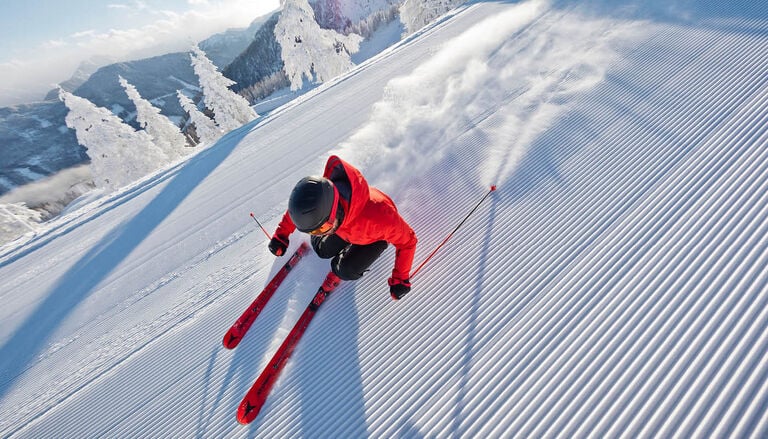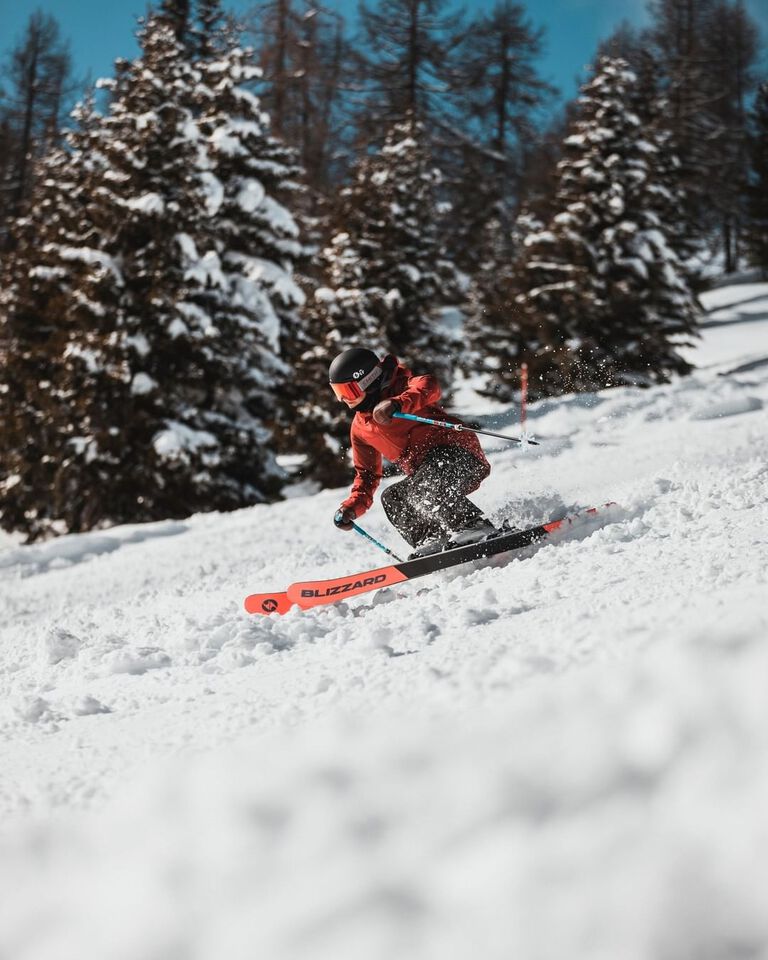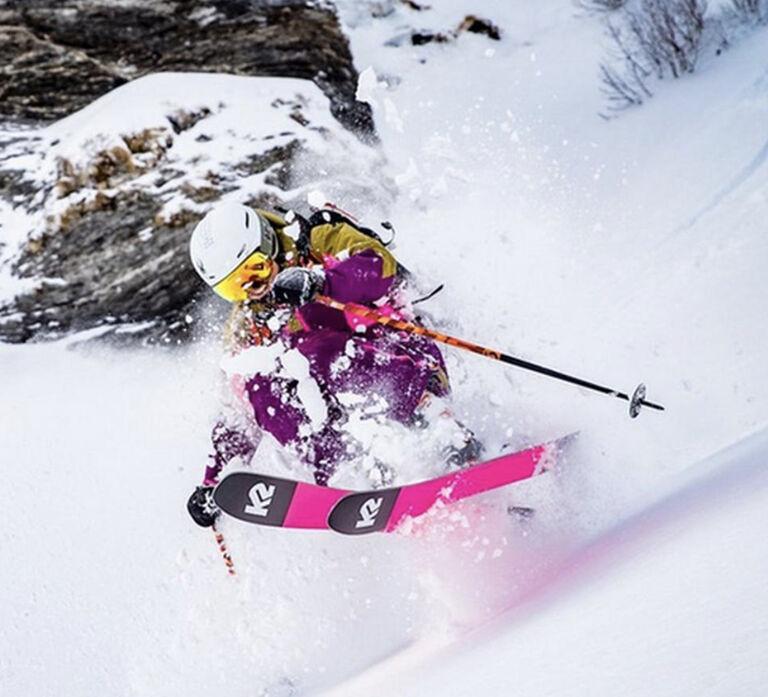
Christy Sports – Ski Buying Guide
HOW TO CHOOSE THE RIGHT PAIR OF SKIS
Choosing the right pair of skis for your needs can make a big difference on the slopes, and our team at Christy Sports wants to help you make an informed decision, whether that is in store or online. Buying skis does not have to be complicated. There are a few important points you should know to help narrow your search and choose the option that is best suited to you. In this buying guide we’ve listed some of the main considerations to help you determine what skis will allow you to perform to the best of your ability.

TERRAIN TYPE
When shopping for skis, most people are looking for a single pair that they can use at any mountain in any conditions. The width underfoot of a ski is the simplest factor that determines whether a ski might be contender to be a “quiver of one,” so to speak. Versatile all-mountain skis that can fit this bill are generally between 90-100mm underfoot and can perform well on terrain ranging from firm groomers to soft powder. Skis narrower than 90mm underfoot are most at home carving on groomed runs but will struggle to stay afloat in deep snow. Skis wider than 100mm underfoot can still perform well in firmer conditions but will be most at home when the snow is deep and soft. Anything wider than 110mm underfoot is designed specifically for use in deep snow. Skiers who like to go fast and ski aggressively on steeper terrain should seek out a stiffer ski that will be more stable at high speeds and in variable snow conditions. Those who like to keep the speeds in check and stay on mellower terrain will often prefer a softer, lighter ski that is easy to flex and turn on a dime at slower speeds. Knowing your capabilities and terrain preferences as a skier will help you pick a ski that is best suited for the way you will use it.

Ski Construction
Knowing a bit about a ski’s construction will help you understand how it might perform. Modern skis are generally constructed with a wood core interlaid with metal or some sort of composite element like carbon or fiberglass. Skis with metal in the construction will often be on the stiffer and heavier side of the spectrum. They offer a damp, smooth ride and are stable at high speeds. More aggressive skiers often prefer these characteristics. Skis without metal in the construction tend to be lighter and more flexible. They will often feel livelier and more poppy and are easy to turn and control but are often less stable at higher speeds or in variable snow. There is much more nuance and detail than this that can be added to one’s understanding of ski construction but understanding this basic difference of skis with metal vs. those without will help you better understand how a ski’s construction relates to how it will perform.

SKI PROFILE
A ski’s rocker profile can help further determine how it will perform and suit the needs of the skier in question. Rocker profile refers to the shape of the ski as it is viewed from its side sitting on the snow. Most modern all-mountain skis have rocker in the tip, meaning the tip of the ski curves up off the ground, and a lesser amount of rocker in the tail, meaning the tail of the ski splays up just a bit from the ground. They will also usually have camber underfoot, meaning the middle of the ski bends back away from the ground. Camber helps give the ski edge grip when carving, helps give it a poppy and energetic quality, and helps to create the turning radius of the ski when it is put on edge and pressed. Rocker helps with easy turn initiation and helps the ski to float above deeper snow. You may often hear of skis referred to as “twin tips.” This means that the ski has a more symmetrical rocker profile at both tip and tail. Twin tip skis are designed for freestyle skiing and are meant to be easy to ski backwards, or “switch.” Wide powder skis will have much more significant tip rocker, which allows them to float better in deep snow. They can sometimes even be “full rocker,” meaning the ski has no camber and is fully rockered from tip to tail. Narrower skis meant for carving on groomers will often have more minimal rocker at the tip and no rocker at the tail, allowing them to utilize more of the ski’s edge to create powerful turns on firm snow. In general, however, the happy medium of some rocker at tip and tail and camber underfoot is best for most skiers in most conditions.

Ability Level and Ski Length
Optimal ski type and ski length correspond with your ability level as a skier. If you are just getting started as a skier, a softer, more flexible, and narrower ski will be easier to learn on as you become comfortable linking turns and skiing fluidly. You will also want to pick a shorter ski length—somewhere between chin and nose height. A shorter ski will allow you to make turns more easily, allowing you to stay in control and moderate your speed. If you are an intermediate skier, you can think about picking a ski based on the sort of terrain you most like to ski or on your aspirations of where you want to grow your skills. For example, if you want to improve your mogul skills and carving ability, you will likely want to pick an all-mountain ski with a narrower waist such as the Armada Declivity 92 TI. If you want to improve your freestyle skills but still want one ski to do it all, you might consider an all-mountain twin like the Faction Prodigy 2. If you are an intermediate skier, you will want to pick a ski length that falls somewhere in the middle of your face. A relatively shorter ski will be best for easy maneuverability and turning, whereas a longer ski will help you maintain more stability at high speeds but may be harder to maneuver in tight spaces. If you are an advanced to expert level skier, you will want to pick a ski that is about as long as you are tall. With a developed and refined skill set, you will be able to easily turn and maneuver that longer ski and benefit from the added stability it provides. The sky is the limit as far as what kind of ski you might pick—there are numerous great choices for all-mountain quiver killers, or you may be in the market for something more specific. We recommend attending a demo day to figure out what ski you like best! For more information on ski sizing, see our size charts below.
Mens & Womens Size Ski Size Chart
Men's Ski Lengths
| Skier Height (in) | Skier Height (cm) | Expert Ski Length (cm) | Intermediate Ski Length (cm) | Beginner Ski Length (cm) |
|---|---|---|---|---|
| 4'6" | 137 | 140 | 135 | 125 |
| 4'8" | 142 | 145 | 140 | 130 |
| 5'0" | 152 | 155 | 145 | 135 |
| 5'2" | 158 | 165 | 155 | 145 |
| 5'6" | 168 | 175 | 165 | 155 |
| 5'8" | 173 | 180 | 170 | 160 |
| 5'10" | 178 | 185 | 175 | 165 |
| 6'0" | 183 | 190 | 180 | 170 |
| 6'2" | 188 | 195 | 185 | 175 |
| 6'4" | 193 | 195 | 190 | 180 |
Women's Ski Lengths
| Skier Height (in) | Skier Height (cm) | Expert Ski Length (cm) | Intermediate Ski Length (cm) | Beginner Ski Length (cm) |
|---|---|---|---|---|
| 4'8" | 142 | 149 | 139 | 136 |
| 5'0" | 152 | 152 | 142 | 139 |
| 5'2" | 158 | 153 | 146 | 143 |
| 5'4" | 163 | 163 | 153 | 150 |
| 5'6" | 168 | 166 | 156 | 153 |
| 5'8" | 173 | 170 | 160 | 157 |
| 5'10" | 178 | 173 | 163 | 160 |
| 6'0" | 183 | 180 | 170 | 167 |


